Brown or dead spots in your lawn can be a huge source of frustration. They’re not only a terrible eyesore but may make you feel as though you’re losing control of your property.
Depending on the cause, brown or dying spots on your lawn can spread quickly, making your entire lawn look its worst in little to no time at all. Suddenly, your yard is looking like one of the most poorly-maintained properties on the block.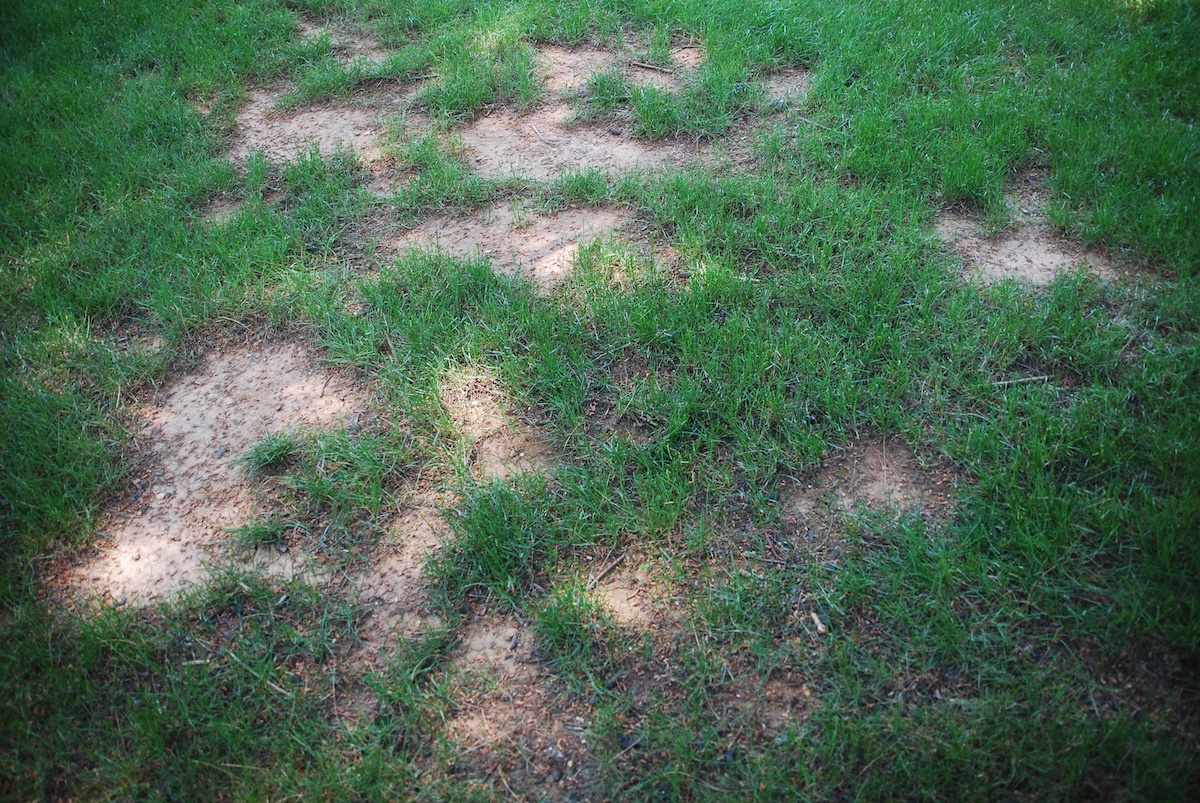 You may be wanting to take control of the situation, but you may not be sure how. You ought to be able to have a nice lawn year round, but you may not be sure what’s wrong with it or how to go about fixing it. That’s why you want to know what you can do about dead spots in the lawn before they get any worse.
You may be wanting to take control of the situation, but you may not be sure how. You ought to be able to have a nice lawn year round, but you may not be sure what’s wrong with it or how to go about fixing it. That’s why you want to know what you can do about dead spots in the lawn before they get any worse.
Brown Spots in Your Lawn Don’t Always Mean Mistakes
We feel it’s important to mention, before delving more into what may be causing dead or brown spots on your lawn, that even the best-cared-for lawns can get brown spots from time to time.
Whether you are currently performing DIY lawn care or you’re working with a professional lawn care company, the truth is, brown spots on the lawn are not always the result of a mistake. Sometimes there are factors outside of your (or your lawn care company’s) control.
Even so, it will help to have a better idea of what to look for. That’s why we’ve rounded up some helpful advice on identifying symptoms and considering root causes.
Why is my Lawn Brown? Some Symptoms to Look For
Getting to the bottom of your lawn problems all starts with a little bit of sleuthing. The truth is, dead spots in the lawn can be caused by quite a few different culprits and determining which one is at fault isn’t exactly easy.
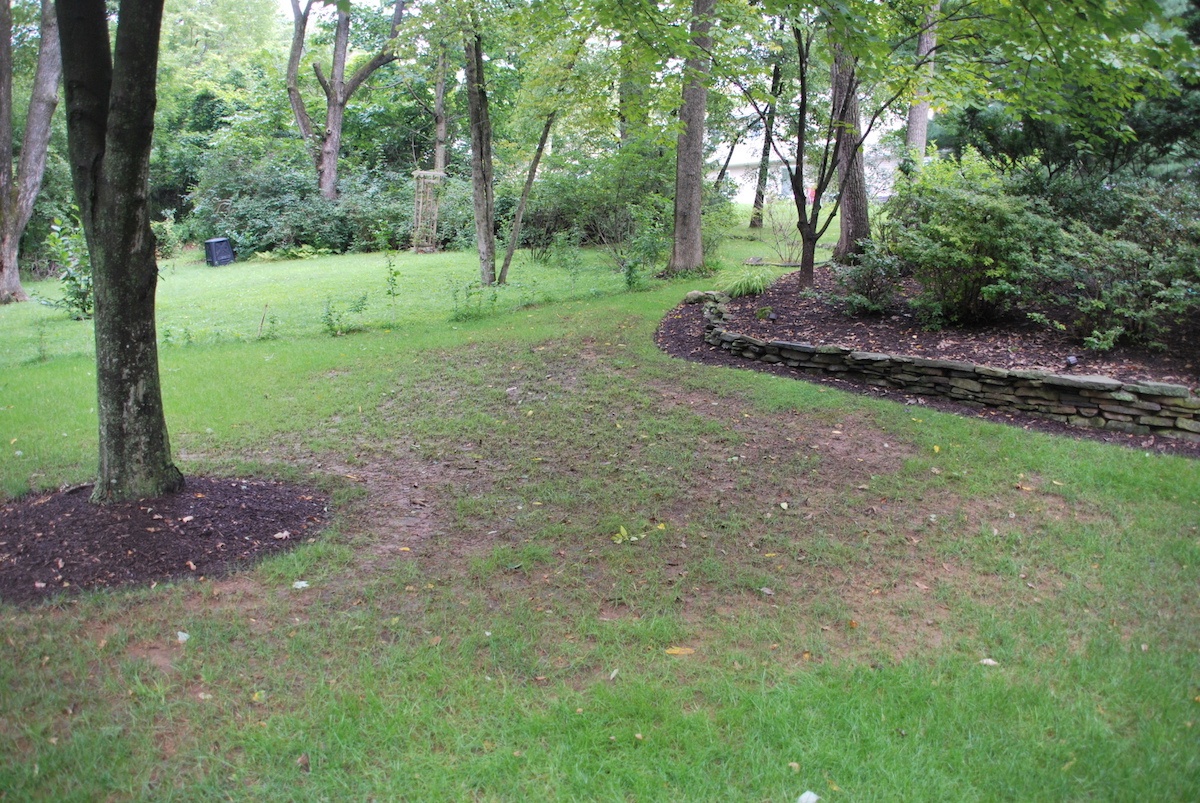 It can help to look for specific symptoms to clue you into what might be causing the brown or dead spots on your lawn. Here are some things that you might notice as you dig deeper into your lawn problem. We’ll get into more detail about the causes of these symptoms later in this article.
It can help to look for specific symptoms to clue you into what might be causing the brown or dead spots on your lawn. Here are some things that you might notice as you dig deeper into your lawn problem. We’ll get into more detail about the causes of these symptoms later in this article.
- Distinct patterns (like rings or irregularly shaped patches)
- Grass changing color from green to yellowish or brown
- An influx of animals like moles, skunks, and birds visiting your yard (and gathering around brown patches)
- Lawn that is peeling up or can be rolled like a carpet
- Grass that gets matted down when you walk on it
Dead Spots in the Lawn: Causes to Consider
If you’re trying to figure out why is my lawn dying, then you’ll want to consider some of these common causes. Keep in mind that it may be one or more of these issues. It’s quite common that a lawn can be suffering from multiple problems at the same time, making it even more challenging to get it under control.
Drought Stress
Your grass needs around one to two inches of water each week, dependent upon air temperature and movement. If it is cool and still, the soil will retain more moisture.
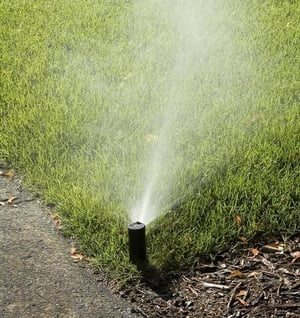 Water should either occur naturally from rain or come from your own watering efforts when rain is limited. When there are long periods of dry and hot weather, then it’s quite likely that your brown or dying patches may be due to drought. In the summer, grass responds to high temperatures and a lack of water by wilting, browning, and possible death.
Water should either occur naturally from rain or come from your own watering efforts when rain is limited. When there are long periods of dry and hot weather, then it’s quite likely that your brown or dying patches may be due to drought. In the summer, grass responds to high temperatures and a lack of water by wilting, browning, and possible death.
One way to evaluate whether your brown patches may be the result of drought is to look at the “bounce back factor” of your grass blades. When they’re stepped on do footprints appear or do the blades spring back to life? If it’s not the latter, and your grass is staying matted down when you walk on it, then it’s probably suffering from drought.
Watering the lawn deeply in the morning hours, two to three times per week will help revive your brown areas and keep your lawn looking greener.
Overwatering
This one tends to throw people for a loop. While it’s definitely true that too little water can cause yellowing or brown spots on the lawn, so can too much water. Whether you’ve manually overwatered or your lawn has experienced an excessive amount of rain, soggy turf can lead to quite a few problems.
For one, too much water can actually drown your grassroots. Because grass roots needs oxygen to live, excessive water can fill those air gaps in the soil and actually drown your plants. This will cause the lawn to yellow, brown, then die.
In addition, it’s also important to mention that excessive water can provide conducive conditions for most turf diseases.
Turf Diseases
Diseases are another common cause of brown spots on the lawn. Turf diseases show up in patches throughout the lawn and can spread rampantly if left uncontrolled. 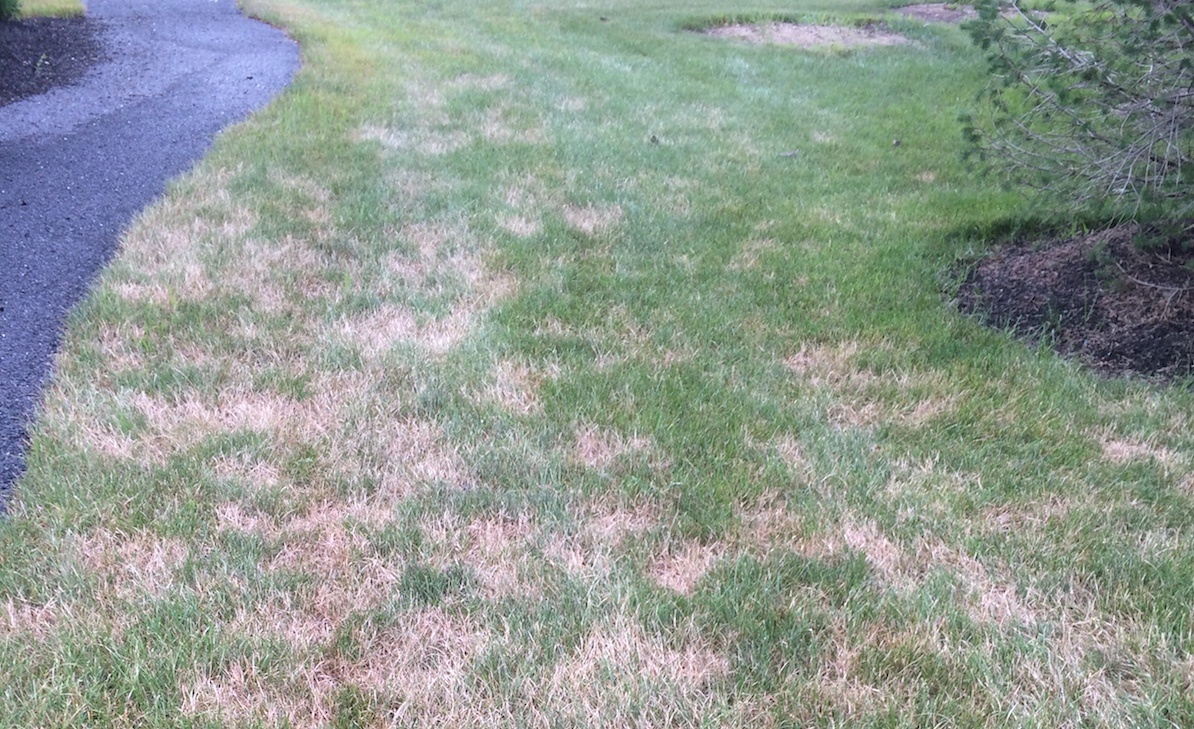 Weather conditions are a major culprit of turf diseases and obviously can’t be controlled. Rainy or humid weather can lead to fungal growth and when there is a lack of sunlight and poor air circulation, then fungal diseases will thrive.
Weather conditions are a major culprit of turf diseases and obviously can’t be controlled. Rainy or humid weather can lead to fungal growth and when there is a lack of sunlight and poor air circulation, then fungal diseases will thrive.
While there are various types of turf diseases in Pennsylvania, and all of them can ultimately lead to brown patches if your grass dies, one to be on the lookout for in particular (due to its namesake) is Brown Patch.
As its name implies, this moisture-loving fungus called Rhizoctonia Solani causes patches of brown grass throughout your lawn. Brown Patch may start out small but it can spread rapidly so you’ll need to get it under control.
It can be incredibly difficult to fully prevent disease, even on a well-maintained lawn in which you’re doing all the right things. Some diseases are aggressive and thrive under certain weather conditions.
Generally, the best course of treatment includes the professional application of fungicides as well as good cultural practices such as avoiding improper watering and over-fertilizing in the middle of the summer.
Lawn Insect Damage
Damage from feeding insects is another cause of brown spots on the lawn. Grubs damage (and kill) your lawn by eating its roots. This will lead to brown patches where the turf has died. Your grass will actually be able to roll up like a carpet in areas where grubs have fed since it no longer has roots attaching it to the earth. 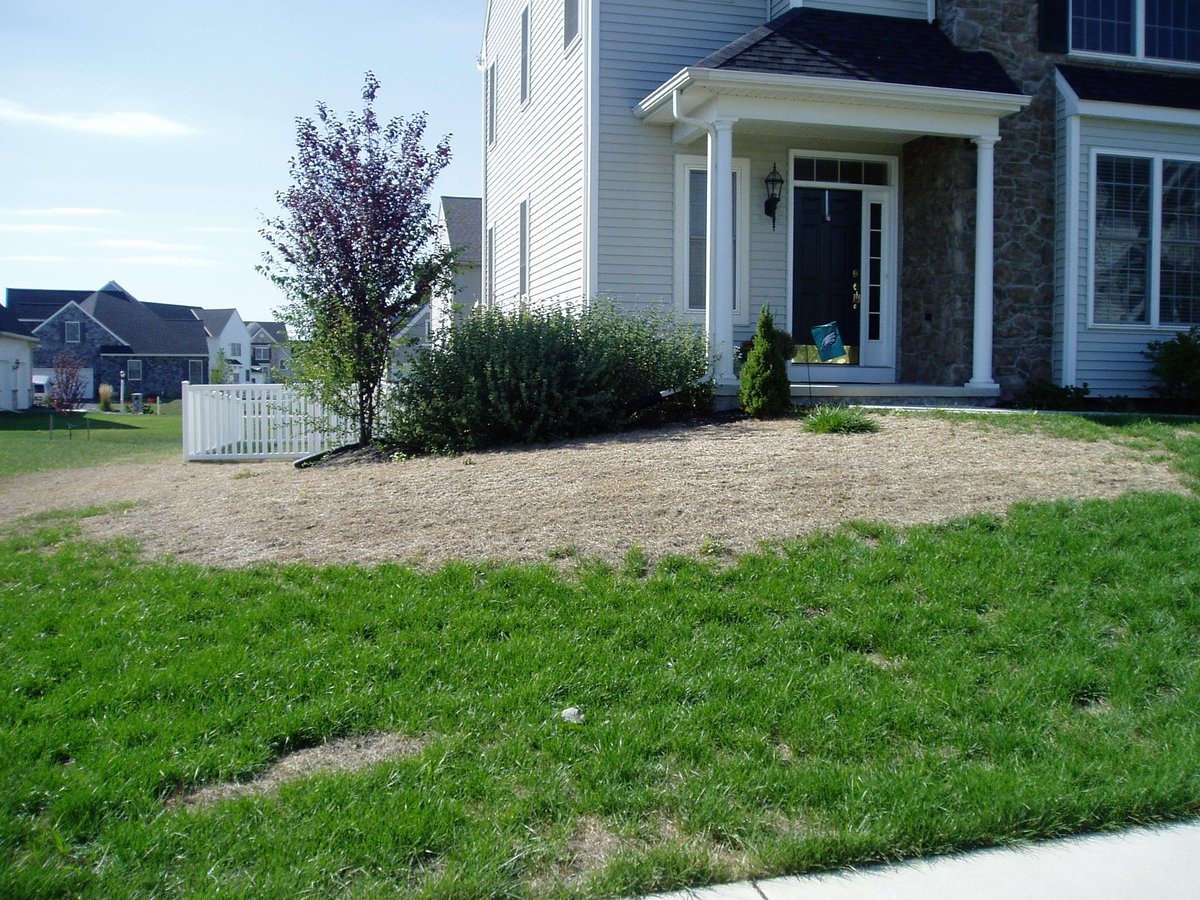 Besides seeing brown patches and turf “roll up,” if you have a grub problem you may also notice a sudden influx of animals visiting your property that feed on grubs (like birds, skunks, and moles). If these animals are hanging around the brown patches, then it’s likely you are dealing with grubs. Grubs feed beneath the surface but are evident to the naked eye when you lift up the dead turf.
Besides seeing brown patches and turf “roll up,” if you have a grub problem you may also notice a sudden influx of animals visiting your property that feed on grubs (like birds, skunks, and moles). If these animals are hanging around the brown patches, then it’s likely you are dealing with grubs. Grubs feed beneath the surface but are evident to the naked eye when you lift up the dead turf.
Chinch bugs and sod webworms can also cause brown patches as a result of eating (and ultimately killing) your grass. You can scout for these pests by getting on your hands and knees and examining your turf closely. Both chinch bugs and sod webworms are very small surface-feeding insects and can be spotted if you look closely enough. You may need to pull back layers of thatch to really examine more closely.
Should you discover that you have a pest problem, there are professional treatments that can be performed to eradicate these insects. However, when it comes to grubs, which are highly destructive, it’s best to prevent these pests in the first place using grub control than it is to be reactive after they’ve already done damage.
Material Damage
If material is improperly applied to your lawn (either in a DIY attempt or by another company), this can also cause damage. Fertilizer burn is caused when too much product is applied to the grass. Excess product can draw moisture out of your grass and cause it to yellow or ultimately brown (and die).
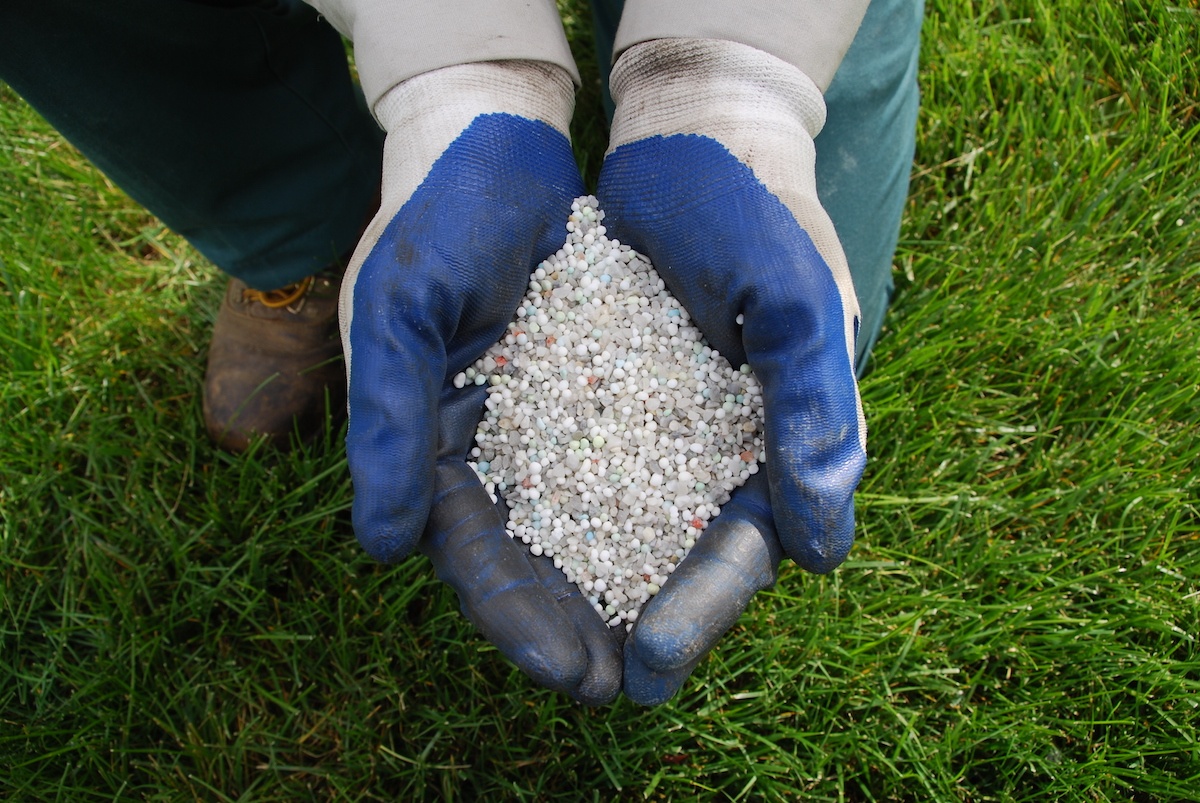
Of course, there are other materials that can cause problems, as well—sometimes materials that weren’t even intended to be applied to the lawn. Chlorine from a drained pool, for instance, could cause grass to brown and die. Salt that was sprayed on the roads but accidentally makes it onto your lawn can also cause problems. Even construction equipment that is cleaned out atop the grass can lead to issues.
At the first sign of fertilizer burn (or any other spill or problem), you should drag out the hose or sprinklers and soak the area. It’s important to have a reasonable expectation in terms of repair. You may need to let those areas fully die out before trying to plant brand-new grass seed. It’s important that no excess chemical is left that will kill your new seedlings. It’s possible that the affected areas may even need to be excavated with new soil added so that healthy grass can successfully grow.
Lawn Soil Concerns
The health of your soil can also come into play when it comes to potential brown patches in your yard. It is quite common for soil to be hard and clay-like. This compacted soil can make it difficult for healthy turf to thrive. That’s because it’s incredibly challenging for water, oxygen, and nutrients to penetrate down to the root zone when the soil structure is so compacted.
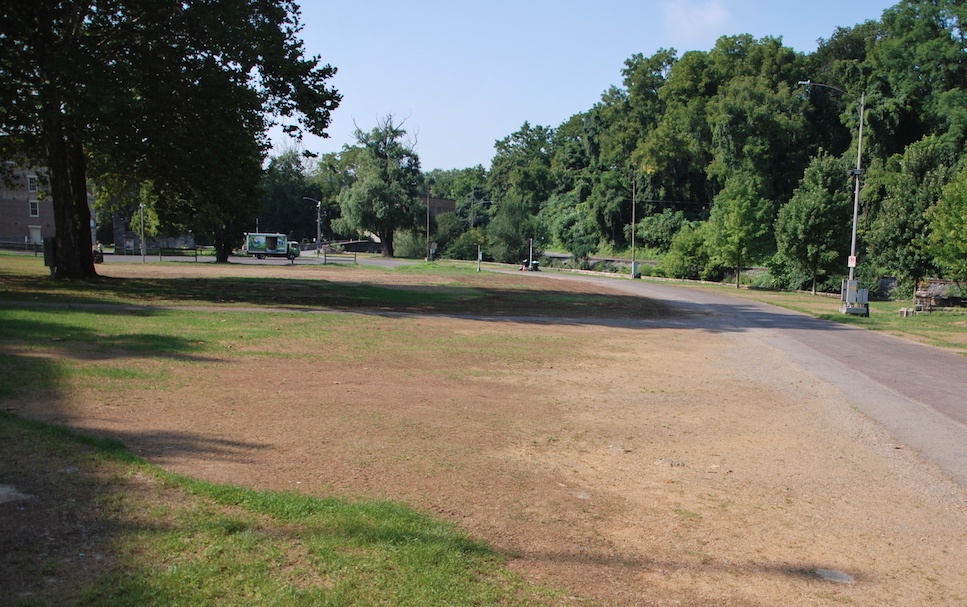
You can determine whether you may have a problem with compaction with a simple test. Dig out a small section with a garden trowel or soil probe within or near a brown patch and also at a green patch.
Take a look at the structure of the soil below. If the area in the brown patch is rocky or filled with clay and the greener section seems to be slightly porous and rich in organic matter, then you could be dealing with compacted or poor-quality soil in browning areas.
The best solution for compacted soil is lawn aeration, which should be performed every fall. This service helps to break up compacted soil and improve its overall structure. When your lawn is able to finally “breathe,” the brown batches should fill in.
To improve your soil’s overall health as it relates to organic matter, this will take time. Mulching grass clippings, annual aeration, and fertilizing with bionutritional materials over a number of years can help.
Making a Proper Diagnosis
At the end of the day, properly diagnosing the brown or dead spots in your lawn may be difficult without prior experience and training in lawn care. Even knowing some of the symptoms to look for, it’s important to note that many times one problem can easily mimic another. Plus, as mentioned, it’s quite common for a lawn to have more problem than one—occurring simultaneously.
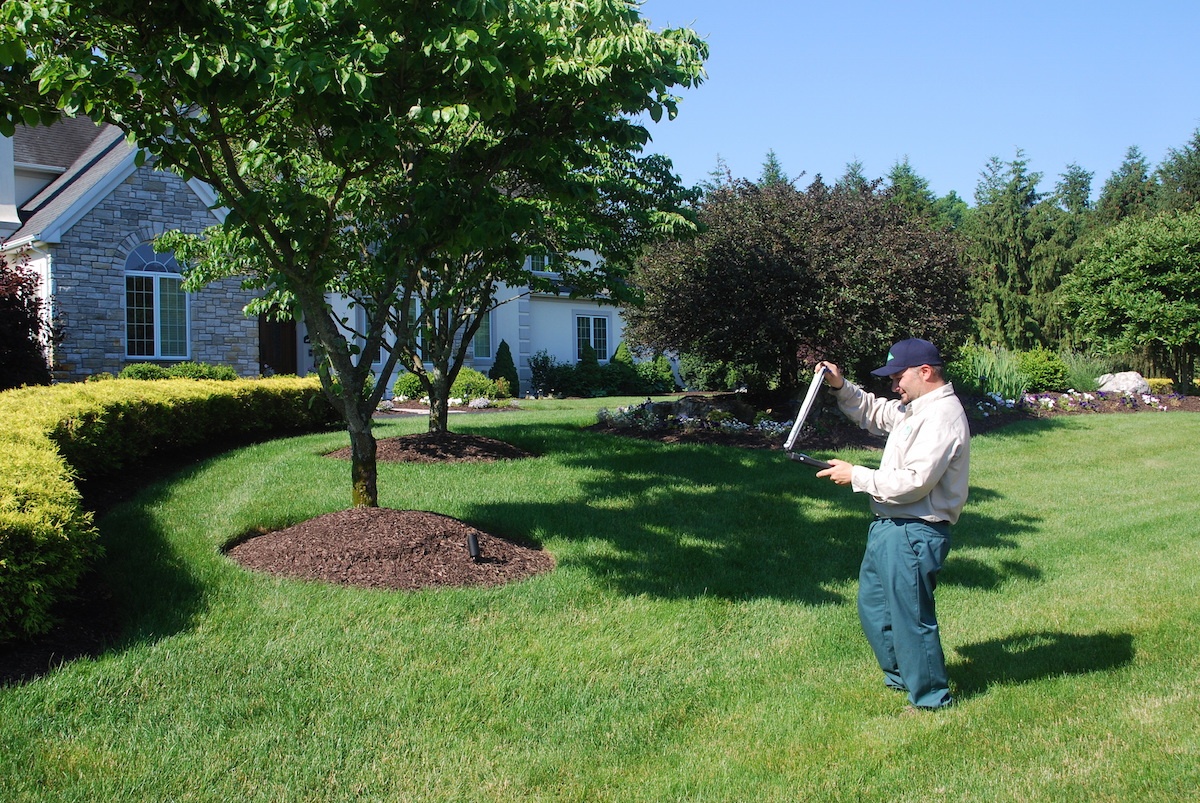
That’s why it’s incredibly beneficial to have a knowledgeable lawn care company perform an evaluation of your lawn. They should be able to tell you exactly what’s going on, and what can be done to fix it—whether it’s something to do on your own or with the help of a pro.
The last thing that you want to do is try to fix the problem and make it worse. If you really want to fix the brown or dead patches in your lawn, you need to make sure you’re educated on what’s really wrong.
A Healthy Lawn in Your Future
How to repair the brown or dead spots in your lawn will depend upon what caused them in the first place. We’ve already mentioned some potential repairs depending upon the causes (such as aeration for compacted soil or fungicides for disease) but a lawn care professional can help you determine which steps are right for you in order to get your lawn on its way to better health.
You might also want to consider some healthy practices to keep your lawn in good shape after addressing some of its specific concerns. Getting on a regular lawn care program can help promote a healthier lawn and prevent some of these problems from happening in the first place. That’s because a healthy lawn will provide the best possible defense against disease, pests, and environmental stressors.
While some problems are difficult to avoid, the better shape that your lawn is, the better it will perform. Generally, that means reducing and ultimately eliminating brown spots and letting beautiful, green grass fill in. With the right care, your lawn can be on its way to looking its best.
With the right care for your lawn, you’ll gain valuable peace of mind. If you’re interested in having your lawn inspected and its health assured, contact us for a free quote or give us a call at 833-JTE-TREE.



